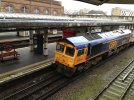OldandRambling
Member
- Joined
- 15 Jun 2018
- Messages
- 133
In the 1970's, I worked for British Rail as a secondman, and I noticed a few of the diesel locomotives at our East London Stratford depot had an extra "stop****" attached to a brake tube fitted just above the rail level.
I was told these locos were so fitted to allow them to run over the "above ground" Central Line sections out towards Epping.
I was told it was an arrangement to facilitate track working on the Central line at night, but possibly before my time on the railway, as I never knew of this happening in my time there.
Is there any info on the web available about this, and where the line were joined?
I was told these locos were so fitted to allow them to run over the "above ground" Central Line sections out towards Epping.
I was told it was an arrangement to facilitate track working on the Central line at night, but possibly before my time on the railway, as I never knew of this happening in my time there.
Is there any info on the web available about this, and where the line were joined?


